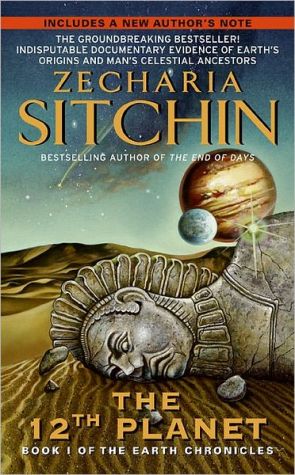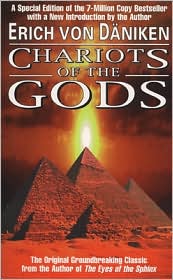The 12th Planet: Book I of the Earth Chronicles, Vol. 1
Over the years, startling evidence has been unearthed, challenging established notions of the origins of Earth and life on it, and suggests the existence of a superior race of beings who once inhabited our world. The product of thirty years of intensive research, THE 12TH PLANET is the first book in Zecharia Sitchin's prophetic Earth Chronicles series — a revolutionary body of work that offers indisputable documentary proof of humanity's extraterrestrial forefathers. Travelers from the stars,...
Search in google:
Dear Reader, The Earth Chronicles series is based on the premise that mythology is the depository of ancient recollections, that the Bible should be read literally as a historic-scientific document, and that ancient civilizations were the product of knowledge brought to Earth by the Anunnaki-- “Those who from Heaven to Earth came.” Complementing each other and serving to bring the saga of gods and humans on Earth ever closer to our time, each book of the series looks at this awesome tale from a different perspective. The 12th Planet, the first book of the series, brings to life the Sumerian civilization and presents millennia-old evidence of the existence of Nibiru, the home planet of the Anunnaki, and the landings of the Anunnaki on Earth every 3,600 years. The Stairway to Heaven, the second book, incorporates ancient Egyptian evidence to show that the gateway between the mortal and the divine was a spaceport in the Sinai Peninsula, with the Giza pyramids and the Sphinx serving as beacons for the landings. The Wars of Gods and Men, the third book, additionally embraces Canaanite, Hittite, and Hindu sources to include in these investigations the incidents of the Tower of Babel and the upheaval of Sodom and Gomorrah, concluding that nuclear weapons were used on Earth 4,000 years ago. The Lost Realms, the fourth book, transports readers to the pre-Columbian civilizations and ancient empires of the Americas, revealing hitherto unrecognized golden links between ancient Near Eastern civilizations and the “cities of the gods” of the Olmecs, Mayas, Aztecs, and Incas. When Time Began, the fifth book, explores ancient knowledge of Heaven and Earth and the interwoven cycles that gave rise to astronomy, the zodiac and astrology, and stone calendars such as Stonehenge, revealing the secret of New Ages past and future. And The Cosmic Code, the sixth book in the series, explains how the secrets of humankind’s celestial teachers were encoded in the Bible and other sacred and hidden “books”--a cosmic code that links Earthlings to their cosmic roots. In the years since each book was published, new scientific discoveries have provided mounting corroboration of the series’ incredible and unorthodox science-based conclusions. This accumulation of discoveries and the origins of humankind and the solar system are further discussed in the companion books Genesis Revisited and Divine Encounters. I trust that modern science will continue to confirm ancient knowledge. Zecharia Sitchin was born in Russia and grew up in Palestine, where he acquired a profound knowledge of modern and ancient Hebrew, other Semitic and European languages, the Old Testament, and the history and archaeology of the Near East. A graduate of the University of London with a degree in economic history, he worked as a journalist and editor for many years prior to undertaking his life’s work--The Earth Chronicles. One of the few scholars able to read the clay tablets and interpret ancient Sumerian and Akkadian, Sitchin based The Earth Chronicles series on the texts and pictorial evidence recorded by the ancient civilizations of the Near East. His books have been widely translated, reprinted in paperback editions, converted to Braille for the blind, and featured on radio and television programs. He now lives and writes in New York City. Library Journal “Exciting . . . credible . . . most provocative and compelling. The 12th Planet presents documentation for a radical new theory which, by answering some age-old questions, merely widens the ripples in the pool. (As the author notes, “If the Nefilim . . . created Man on Earth, who created the Nefilim?”)
Chapter One\ ENDLESS BEGINNING\ Of the evidence that we have amassed to support our conclusions, exhibit number one is Man himself. In many ways, modem man -- Homo sapiens -- is a stranger to Earth.\ Ever since Charles Darwin shocked the scholars and theologians of his time with the evidence of evolution, life on Earth has been traced through Man and the primates, mammals, and vertebrates, and backward through everlower life forms to the point, billions of years ago, at which life is presumed to have begun.\ But having reached these beginnings and having begun to contemplate the probabilities of life elsewhere in our solar system and beyond, the scholars have become oneasy about life on Earth: Somehow, it does not belong here. If it began through a series of spontaneous chemical reactions, why does life on Earth have but a single source, and not a multitude of chance sources? And why does all living matter on Earth contain too little of the chemical elements that abound on Earth, and too much of those that are rare on our planet?\ Was life, then, imported to Earth from elsewhere?\ Man's position in the evolutionary chain has compounded the puzzle. Finding a broken skull here, a jaw there, scholars at first believed that Man originated in Asia some 500,000 years ago. But as older fossils were found, it became evident that the mills of evolution grind much, much slower. Man's ancestor apes are now placed at a staggering 25,000,000 years ago. Discoveries in East Africa reveal a transition to manlike apes (horninids) some 14,000,000 years ago. It was about 11,000,000 years later that the first ape-man worthy of theclassification Homo appeared there.\ The first being considered to be truly manlike --"Advanced Australopithecus" -- existed in the same parts of Africa some 2,000,000 years ago. It took yet another million years to produce Hom erectus. Finally, after another 900,000 years, the first primitive Man appeared; be is named Neanderthal after the site where his remains were first found.\ In spite of the passage of more than 2,000,000 years between Advanced Australopithecus and Neanderthal, the tools of these two groups-sharp stones-were virtually alike; and the groups themselves (as they are believed to have looked) were hardly distinguishable. (Fig. 1)\ Then, suddenly and inexplicably, some 35,000 years ago, a new race of Men -- Homo sapiens ("thinking Man")appeared as if from nowhere, and swept Neanderthal Man from the face of Earth. These modern Men -- named Cro-Magnon -- looked so much like us that, if dressed like us in modern clothes, they would be lost in the crowds of any European or American city. Because of the magnificent cave art which they created, they were at first called "cavemen." In fact, they roamed Earth freely, for they knew how to build shelters and homes of stones and animal skins wherever they went.\ For millions of years, Man's tools had been simply stones of useful shapes. Cro-Magnon Man, however, made specialized tools and weapons of wood and bones. He was no longer a "naked ape," for he used skins for clothing. His society was organized; he lived in clans with a patriarchal hegemony. His cave drawings bespeak artistry and depth of feeling; his drawings and sculptures evidence some form of "religion," apparent in the worship of a Mother Goddess, who was sometimes depicted with the sign of the Moon's crescent. He buried his dead, and must therefore have had some philosophies regarding life, death, and perhaps even an afterlife.\ As mysterious and unexplained as the appearance of Cro-Magnon Man has been, the puzzle is still more complicated. For, as other remains of modem Man were discovered (at sites including Swanscombe, Steinheim, and Montmaria), it became apparent that Cro-Magnon Man stemmed from an even earlier Hom sapiens who lived in western Asia and North Africa some 250,000 years before Cro-Magnon Man.\ The appearance of modem Man a mere 700,000 years after Homo erectus and some 200,000 years before Neanderthal Man is absolutely implausible. It is also clear that Homo sapiens represents such an extreme departure from the slow evolutionary process that many of our features, such as the ability to speak, are totally unrelated to the earlier primates.\ An outstanding authority on the subject, Professor Theodosius Dobzbansky (Mankind Evolving), was especially puzzled by the fact that this development took place during a period when Earth was going through an ice age, a most unpropitious time for evolutionary advance. Pointing out that Homo sapiens lacks completely some of the peculiarities of the previously known types, and has some that never appeared before, be concluded: "Modern man has many fossil collateral relatives but no progenitors!, the derivation of Homo sapiens, then, becomes a puzzle.\ How, then, did the ancestors of modem Man appear some 300,000 years ago -- instead of 2,000,000 or 3,000,000 years in the future, following further evolutionary development? Were we imported to Earth from elsewhere, or were we, as the Old Testament and other ancient sources claim, created by the gods?\ We now know where civilization began and how it developed, once it began. The unanswered question is: Why -- why did civilization come about at all? For, as most scholars now admit in frustration, by all data Man should still be without civilization. There is no obvious reason that we should be any more civilized than the primitive tribes of the Amazon jungles or the inaccessible parts of New Guinea.\ But, we are told, these tribesmen still live as if in the Stone Age because they have been isolated. But isolated from what? If they have been living on the same Earth as we, why have they not acquired the same knowledge of sciences and technologies on their own as we supposedly have?\ The real puzzle, however, is not the backwardness of the Bushmen, but our advancement; for it is now...
Author's Note\ Prologue: Genesis\ 1 The Endless Beginning\ 2 The Sudden Civilization\ 3 Gods of Heaven and Earth\ 4 Sumer: Land of the Gods\ 5 The Nefilim: People of the Fiery Rockets\ 6 The Twelfth Planet\ 7 The Epic of Creation\ 8 Kingship of Heaven\ 9 Landing on Planet Earth\ 10 Cities of the Gods\ 11 Mutiny of the Anunnaki\ 12 The Creation of Man\ 13 The End of All Flesh\ 14 When the Gods Fled from Earth IS Kingship on Earth\ Sources\ Index
\ East-West Magazine"One of the most important books on Earth’s roots ever written."\ \ \ \ \ United Press International“Heavyweight scholarship...Now a recognized scholar has come forth with a theory that is the most astonishing of all.”\ \ \ East-West Magazine“One of the most important books on Earth’s roots ever written.”\ \ \ \ \ United Press International“For thousands of years priests, poets, and scientists have tried to explain how man was created. . . . Now a recognized scholar has come forth with a theory that is the most astonishing of all.”\ \ \ \ \ Wisdom Quarterly: American Buddhist Journal" . . . [supplies] an array of evidence to support the assertion that the earth had been visited by ancient alien astronauts in its past. Sitchin based his conclusions on the written records of Sumer, the 'sudden civilization' that sprang up virtually overnight in the Tigris-Euphrates Valley of modern Iraq. . . . he found an astonishing array of facts that could be corroborated by modern research. What he found was literally mind boggling in 1976, and it remains so today."\ \ \ \ \ East West Journal"One of the most important books on Earth's roots ever written."\ \ \ \ \ Rosemary Decker"Sitchin's works are outstandingly different from all others that present this central theme. His linguistic skills in the languages of antiquity and his pursuit of the earliest available texts and artifacts make possible the wealth of photographs and line drawings appearing in his books from tablets, monuments, murals, pottery, and seals."\ \ \ \ \ News Worth World in Perspective"Read this book to see from a perspective not often offered. Read it to expand your picture of our tiny existence. And beyond that, just enjoy the theorizing and information provided. There are few places that you can find such a compilation."\ \ \ \ \ American Buddhist Journal" . . . an array of evidence to support the assertion that the earth had been visited by ancient alien astronauts in its past. Sitchin based his conclusions on the written records of Sumer, the "sudden civilization" that sprang up virtually overnight in the Tigris-Euphrates Valley of modern Iraq."\ \ \ \ \ Wisdom Quarterly: American Buddhist Journal" . . . [supplies] an array of evidence to support the assertion that the earth had been visited by ancient alien astronauts in its past. Sitchin based his conclusions on the written records of Sumer, the 'sudden civilization' that sprang up virtually overnight in the Tigris-Euphrates Valley of modern Iraq. . . . he found an astonishing array of facts that could be corroborated by modern research. What he found was literally mind boggling in 1976, and it remains so today."\ \








